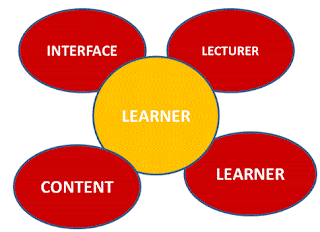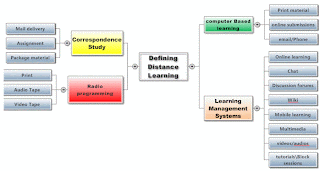Reflection
Twenty
years ago distance learning was rare to find in the society. This was the time
around which I had just completed my undergraduate qualifications and became a
teacher who wanted to integrate technology into the school curriculum through
the use of one odd computer for learners to practice and do mathematics. Both
learners and teachers were learning how to use simple things such as word
document (word perfect at the time) and later on how to use e-mail to send and
receive information. Later on in my career I got engaged in the private sector,
designing and developing e-learning courses for distance learning. Distance
learning had just become a stepping stone for many companies to interact with
different offices around the world (Dr. Siemens in Laureate Education Inc.,
2010). Employees could learn in their own workplaces and homes without the
hassle of travelling. Moller, Foshay, & Huett, (2008)
argue that “the growth of online distance learning is explosive in almost all
sectors” (p.66). Currently, growth is evidenced all over the society with the
high usage of internet in homes, in schools, at workplaces, places of
entertainment and in higher education institutions.
Simonson,
Smaldino, Albright, and Zvacek, (2012) points out that “distance education will
play a central role in-not-too-distant future, as technology delivered
curricula will be offered by educational institutions and private corporations
on a global basis to anyone, anywhere, at any time” (p.313). Distance education
is already playing a role in my life as I am studying for an online degree
program, communicating with my classmates who are all over the globe, and at
any time of the day. My perception is that in the next five years most of the
higher education courses will either be delivered as an online portion or as a
hybrid course as a result of the pressure from the younger generation of
students who are “more than aware of e-learning’s liberating potential”
(Garrison and Anderson, 2003, p.116). The younger generation of students exerts
pressure to organizations and instructors to accommodate their multitasking
abilities and evolving learning styles. For instance, in a recent follow-up
conversation I had with a lecturer, he stated that he “ has a group of
rebellious students outside his office almost every day demanding duplicates of
what he had taught in class, and the blending of his course to the LMS
(Blackboard)” (Telephone conversation, September 2013). Garrison and Anderson, (2003) point out, “it
is the educators and administrators who must liberate themselves and who must
climb the learning curve in terms of understanding and designing the kinds of
dynamic learning environments that take full advantage of the potential of
e-learning”(p.116). Such demands by the students would seem to suggest that the
future of distance learning is bright. Bates (2013) forecasts that, “From
the periphery to the center: one year 10-30%; three years: 30-50%; five years:
60-80%”. The argument is that “2013 is a terrific year for online learning,
where it has moved from being an interesting sidebar, operating on the fringes
of an institution’s core, to becoming central to an institution’s operation”
(Bates, 2013). This is an indication that in five years’ time; most of the
courses offered in higher education will either be online or have an online
portion as a blended course. There will be more distance learning in the
society by 2018, in part because of the advanced devices such as mobile phones,
tablets and many others.
There
is enough evidence to suggest that there is growth in the use of e-learning in
teaching and learning through distance education. I started working as an
instructional designer in a higher education institution in 2012, mainly
responsible for motivating instructors to integrate a distance learning portion
within their hybrid courses. The graph below shows the growth in module registrations
on Blackboard for example. Out of a
total of 6021 modules at the university , 2876 have already been registered to
be created within the learning management system for the next academic year
(which in our case begin in February, 2014).This has happened even before the
end of the present academic year (which ends in December 2013). As an
instructional designer, I see it as my role to be innovative in designing
distance learning courses that integrate new technology tools in order to draw
the interest of students, instructors and facilitators.
Figure 1: The growth in the number of modules with distance learning
portion
Garrison
& Anderson (2003) argue that “simply replicating face-to-face offerings, or
transmitting volumes of information in an e-learning context, is doomed to
fail” (116). The positive force for continuous improvement can be done through
analysis of current use of distance learning tools and development of plans for
better delivery. The tools that are mostly used by faculty at my university
include uploading content as documents such as PowerPoint presentations and
word documents. 5% of the modules created in the system for the “ABC College”
and 9% for the “XYZ College” at my university for example had no activities at
all (see pie chart below). With the information I have gained from the present
distance learning course at Walden University, I will be in a position to
design online orientation courses for lecturers and students as a way of
improving the use of other technology tools that our internal research has
shown to be in less use within the university (see the pie chart below).
Figure 2: Use of e-learning tools within the Learning Management System (Blackboard) by ABC College
Figure 3: The use of e-learning tools within the Learning Management
system (Blackboard) by XYZ College
References
Bates, T. (06
January 2013). Outlook for online learning in 2013: online learning comes of
age. [Blog]. Retrieved 22 October from http://www.tonybates.ca/2013/01/06/outlook-for-online-learning-in-2013/
Garrison,
D., & Anderson, T. (2003). E-learning
in the 21st century: A framework for research and practice. London,
England: Routledge/Falmer.
Laureate
Education, Inc. (Producer). (2010). Future of Distance Education [Video
webcast].
Retrieved from http://mym.cdn.laureate-media.com/Walden/EDUC/6135/08/downloads/WAL_EDUC6135_07_A_EN-DL.zip
Moller, L.,
Foshay, W., & Huett, J. (2008). The evolution of distance education:
Implications for instructional design on the potential of the web (Part 2:
Higher education). TechTrends, 52(4),
66-70.
Simonson, M., Smaldino, S.,
Albright, M., & Zvacek, S. (2012). Teaching
and learning at a distance: Foundations of distance education (5th Ed.)
Boston, MA: Pearson.










